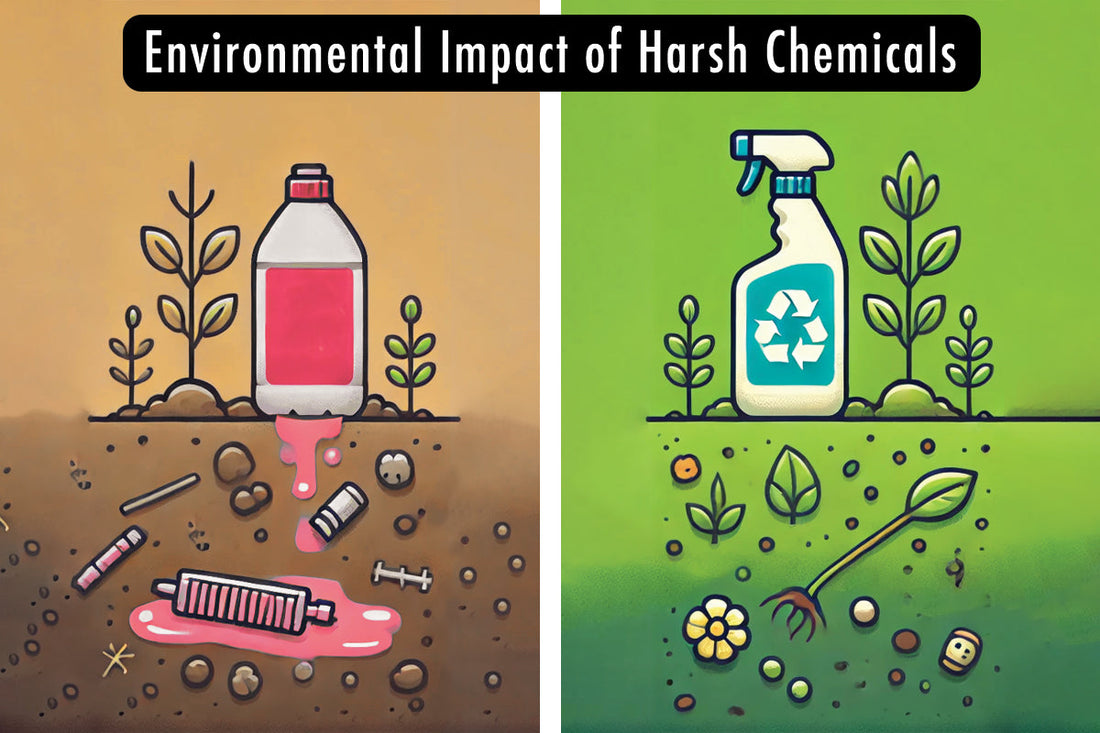
The Environmental Impact of Harsh Cleaning Chemicals
Share
The Eco-Cost of Conventional Cleaning Products
Most people don’t think twice about washing their floors or scrubbing their countertops. But the harsh chemicals in many cleaning products come with an invisible price tag—polluting our water, air, soil, and climate long after we rinse them away.
From toxic runoff that poisons marine life to airborne pollutants that worsen respiratory conditions, traditional cleaners are contributing to an environmental crisis. Here’s what you need to know about their impact—and why it’s time to switch to safer, eco-friendly alternatives.
Water Pollution: The Silent Killer of Aquatic Life
Every time we rinse cleaning products down the drain, we may be sending toxic chemicals into our water supply. Many ingredients in conventional cleaners don’t break down easily, causing long-term pollution.
Phosphates and Nitrogen Compounds – Found in detergents, these chemicals contribute to harmful algal blooms that create dead zones in oceans and lakes, suffocating marine life (EPA, 2022).
Chlorine Bleach and Ammonia – These highly reactive chemicals can kill fish and disrupt aquatic ecosystems at even low concentrations (American Chemical Society, 2020).
Surfactants and Preservatives – Ingredients like nonylphenol ethoxylates (NPEs) mimic hormones, causing reproductive issues in fish and bioaccumulating in marine food chains (National Institutes of Health, 2021).
Impact: Declining Water Quality and Marine Biodiversity
-
Over 40% of U.S. rivers and lakes are too polluted for fishing and swimming, with cleaning product chemicals as a major contributor (U.S. Geological Survey, 2021).
-
Toxic contamination affects drinking water, increasing health risks for humans and animals (World Health Organization, 2022).
Air Pollution: The Unseen Toxins in Your Home and Office
Many cleaning sprays and disinfectants release volatile organic compounds (VOCs), which contribute to indoor and outdoor air pollution.
Ammonia and Chlorine Gas – Strong-smelling fumes from household cleaners can trigger asthma, lung irritation, and chronic respiratory issues (American Lung Association, 2021).
Fragrances and Air Fresheners – Many contain phthalates, which are linked to hormone disruption and reproductive health issues (Endocrine Society, 2019).
Aerosols and Propellants – Sprays release tiny airborne toxins that can linger for hours, worsening indoor air quality and contributing to smog outdoors (EPA, 2022).
Impact: Poor Air Quality and Long-Term Health Effects
-
Studies show that regular use of spray cleaners increases the risk of asthma by 30-50% (Svanes et al., 2018, American Journal of Respiratory and Critical Care Medicine).
-
VOCs from cleaning products are as harmful to air pollution as car emissions, according to a study from the University of California (2018).
Soil Contamination: Toxic Residues That Last for Decades
When cleaners are improperly disposed of—or when wastewater isn’t treated properly—their toxic ingredients accumulate in soil, harming plant life and ecosystems.
Quaternary Ammonium Compounds (Quats) and Disinfectants – These chemicals kill beneficial soil microbes, disrupting natural decomposition and plant growth (National Institute of Environmental Health Sciences, 2020).
Heavy Metals and Synthetic Preservatives – Found in industrial cleaners, these substances persist in the environment, contaminating agricultural land (U.S. Geological Survey, 2021).
Impact: Ecosystem Damage and Reduced Soil Fertility
-
Contaminated soil leads to toxic food sources for wildlife and humans.
-
Microorganisms essential for breaking down organic matter die off, weakening soil’s ability to support plant life.
Climate Change: How Cleaning Products Contribute to Global Warming
Petroleum-Based Ingredients – Many conventional cleaners are derived from fossil fuels, contributing to greenhouse gas emissions during production (Intergovernmental Panel on Climate Change, 2021).
Plastic Waste – Most cleaning products are packaged in non-recyclable plastic bottles, adding to landfill and ocean pollution (National Oceanic and Atmospheric Administration, 2022).
Aerosol Sprays & Propellants – These contain chemicals that deplete the ozone layer and worsen global warming (EPA, 2022).
Impact: Environmental Harm Beyond the Cleaning Process
-
The cleaning industry produces thousands of tons of CO₂ annually.
-
91% of plastic packaging from household cleaning products is never recycled, worsening plastic waste pollution (NOAA, 2022).
Solution: Switch to Eco-Friendly Cleaning Alternatives
It’s clear: harsh chemical cleaners are harming the planet. But the good news is that we can choose to clean a safer and more sustainable way.
🌱 Safer, biodegradable, non-toxic cleaning solutions are just as effective without polluting our water, air, soil, or climate.
At CG Chemicals, we are committed to offering eco-friendly, powerful cleaning solutions that keep homes and workplaces clean without environmental harm.
Our products are:
- Non-toxic – Free from harsh chemicals that poison ecosystems.
- VOC-free – No harmful fumes polluting the air.
- Biodegradable – Naturally breaks down, leaving no harmful residue.
- Sustainably packaged – Reducing plastic waste and carbon emissions.
It’s time to clean responsibly. It's time to clean smarter.
Shop now or contact us to learn more about our eco-friendly cleaning products!
Sources: Environmental Protection Agency (EPA) (2022). Effects of Cleaning Chemicals on Water & Air Quality. American Lung Association (2021). Indoor Air Quality and Cleaning Products. National Institutes of Health (2021). Toxicology of Household Cleaners. Endocrine Society (2019). Phthalates and Hormone Disruption. Intergovernmental Panel on Climate Change (2021). Carbon Emissions from Consumer Goods. U.S. Geological Survey (2021). Contaminants in U.S. Water and Soil. National Oceanic and Atmospheric Administration (NOAA) (2022). Plastic Waste in the Environment. Svanes et al. (2018). American Journal of Respiratory and Critical Care Medicine.
